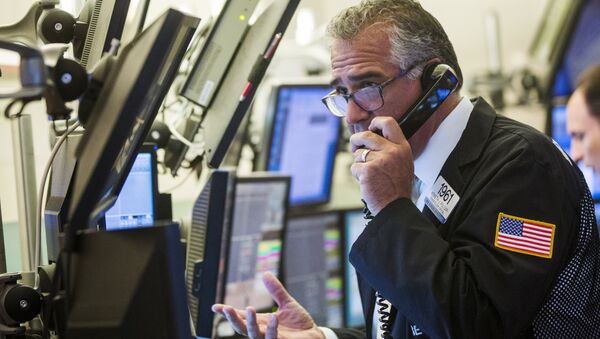Kristian Rouz — Wall Street posted losses, with stocks retreating on weak macroeconomic data, while the dollar rally, having cut down corporate earnings due to weaker overseas sales, added to investors' concerns. The S&P and Nasdaq ended the week with their biggest losses since March due to a decline in the raw materials and biotech sectors, while the Dow posted its largest weekly losses since January.
Another concern was the performance of the US real economy. Sales of new homes in the US suddenly dropped in June to a seven-month low, 6.8% down to the annualized pace of 482,000, sending the S&P Homebuilding Supercomposite Index down 1.3%. The average price for a new house also tumbled to $281,000, 1.8% down.
On a brighter note, the online retailer Amazon saw its stock skyrocket over 20% before settling 9.8% higher at the close on Friday. The retailer's Q2 profits unexpectedly surpassed earlier predictions, resulting in Amazon now being the tenth-biggest US enterprise by market value. However, only three more S&P-listed companies performed as well as Amazon, with others struggling. One of them, the plastic card-maker Visa, Inc., rose 4.3% as its earnings also beat forecasts.
All in all, the three major indices all slid. The S&P 500 lost 22.5 points, or 1.07%, to 2,079.65 points, while the Dow Jones shed 163.39 points, or 0.92%, to 17,568.63 points. The tech-driven Nasdaq Index lost 57.78 points, or 1.12%, to 5,088.63 points.
Weekly losses for the S&P were 2.2%, while the Nasdaq shed 2.3% over the week, both retreating the most since March. Meanwhile, as the Dow lost some 2.9%, posting its biggest drop since January, the anticipated September hike in US borrowing costs is put into question once again.
The bear market accelerated on Friday after the Democrat presidential candidate Hillary Clinton attacked 'quarterly capitalism' in her speech that same day, having also proposed to double the capital gains tax on short-term investment. The Lefties might think of that as a measure to curb market speculation, but in fact an increased tax burden might undermine US investment in general, weighing on the overall growth as the gravest consequence.
Now, as the earnings season is over, its results are somewhat mixed. The US dollar, which is 20% more expensive than a year ago, weighed on corporate profits, in line with earlier predictions, as overseas operations of US companies suffered a decline in returns. While the trend is a healthy one for the broader US economy as it spurs the ongoing reshoring of capital and facilities, thus supporting the labor market and productivity, the short-term effects are negative.
The US market is still overbought, despite losses, with the S&P 500 trading at 16.9 times next year's earnings, which is just above the 10-year average figure of 14.7, according to data from StarMine. It is still far below the alarming figure of 25, indicating a stock bubble.
The volatility index, or VIX, rose 8.7% percent on Friday, extending its weekly gains to 15% after the measure slumped 29% last week after Greek concerns eased. Now, the rising stock volatility is heating demand for fixed income.
Still, the consensus forecast on the US Fed policy action is standing at a 50% chance of a September hike in borrowing costs, even though the US and global economic data has been weak. A positive factor for the US economy is the reshoring of manufacturing facilities unexpectedly pushed the US industrial performance in July up from the weakest since October 2013 the previous month. According to Markit data, the US manufacturing activity rose to 53.8 in July (figures above 50 indicate expansion), as output and Q3 orders gained momentum.
Even though, the short-term outlook is the ever-sliding oil, which the greenback is poised to extend its gains before the US Fed signals more clarity of its rate hike planning.





